Analyzing the Affordable Care Act: Key Components, Health Economic Theory, and Policy Solutions
VerifiedAdded on 2023/06/10
|7
|1564
|138
AI Summary
This assignment analyzes the key components of the Affordable Care Act, the benefits from the health insurance to the individuals and the society from the Health Economic theory and policy solutions. It also proposes approaches that policy makers can use to intervene.
Contribute Materials
Your contribution can guide someone’s learning journey. Share your
documents today.
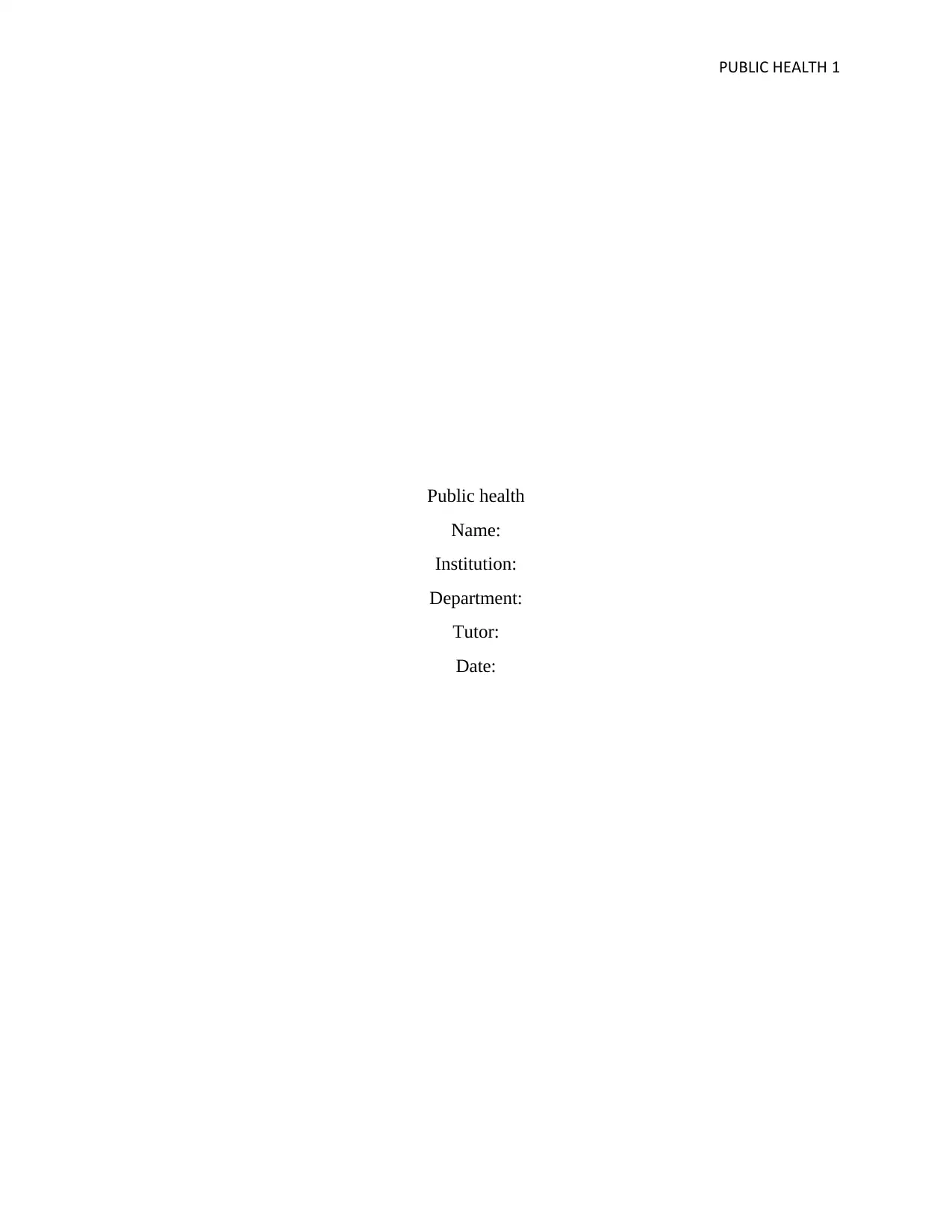
PUBLIC HEALTH 1
Public health
Name:
Institution:
Department:
Tutor:
Date:
Public health
Name:
Institution:
Department:
Tutor:
Date:
Secure Best Marks with AI Grader
Need help grading? Try our AI Grader for instant feedback on your assignments.
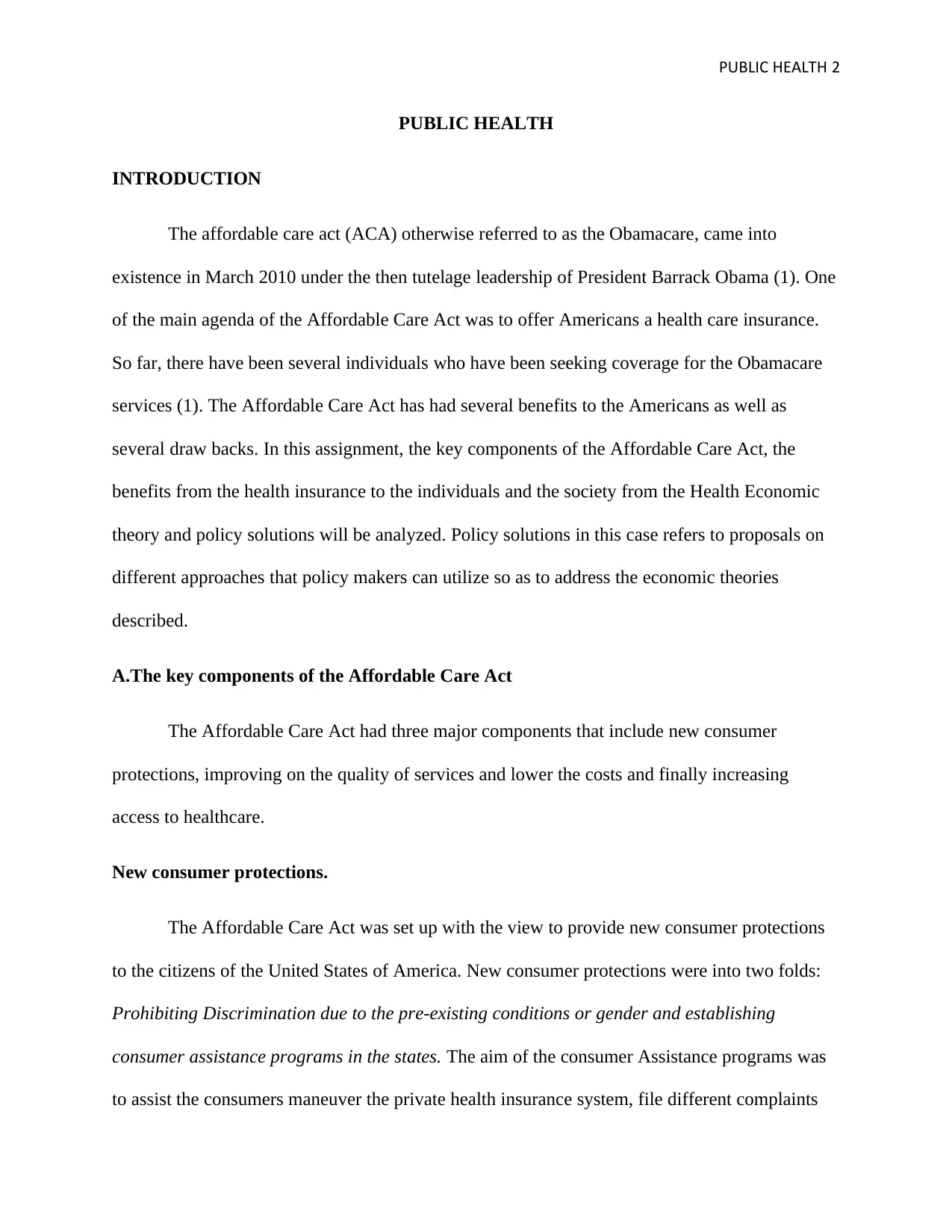
PUBLIC HEALTH 2
PUBLIC HEALTH
INTRODUCTION
The affordable care act (ACA) otherwise referred to as the Obamacare, came into
existence in March 2010 under the then tutelage leadership of President Barrack Obama (1). One
of the main agenda of the Affordable Care Act was to offer Americans a health care insurance.
So far, there have been several individuals who have been seeking coverage for the Obamacare
services (1). The Affordable Care Act has had several benefits to the Americans as well as
several draw backs. In this assignment, the key components of the Affordable Care Act, the
benefits from the health insurance to the individuals and the society from the Health Economic
theory and policy solutions will be analyzed. Policy solutions in this case refers to proposals on
different approaches that policy makers can utilize so as to address the economic theories
described.
A.The key components of the Affordable Care Act
The Affordable Care Act had three major components that include new consumer
protections, improving on the quality of services and lower the costs and finally increasing
access to healthcare.
New consumer protections.
The Affordable Care Act was set up with the view to provide new consumer protections
to the citizens of the United States of America. New consumer protections were into two folds:
Prohibiting Discrimination due to the pre-existing conditions or gender and establishing
consumer assistance programs in the states. The aim of the consumer Assistance programs was
to assist the consumers maneuver the private health insurance system, file different complaints
PUBLIC HEALTH
INTRODUCTION
The affordable care act (ACA) otherwise referred to as the Obamacare, came into
existence in March 2010 under the then tutelage leadership of President Barrack Obama (1). One
of the main agenda of the Affordable Care Act was to offer Americans a health care insurance.
So far, there have been several individuals who have been seeking coverage for the Obamacare
services (1). The Affordable Care Act has had several benefits to the Americans as well as
several draw backs. In this assignment, the key components of the Affordable Care Act, the
benefits from the health insurance to the individuals and the society from the Health Economic
theory and policy solutions will be analyzed. Policy solutions in this case refers to proposals on
different approaches that policy makers can utilize so as to address the economic theories
described.
A.The key components of the Affordable Care Act
The Affordable Care Act had three major components that include new consumer
protections, improving on the quality of services and lower the costs and finally increasing
access to healthcare.
New consumer protections.
The Affordable Care Act was set up with the view to provide new consumer protections
to the citizens of the United States of America. New consumer protections were into two folds:
Prohibiting Discrimination due to the pre-existing conditions or gender and establishing
consumer assistance programs in the states. The aim of the consumer Assistance programs was
to assist the consumers maneuver the private health insurance system, file different complaints
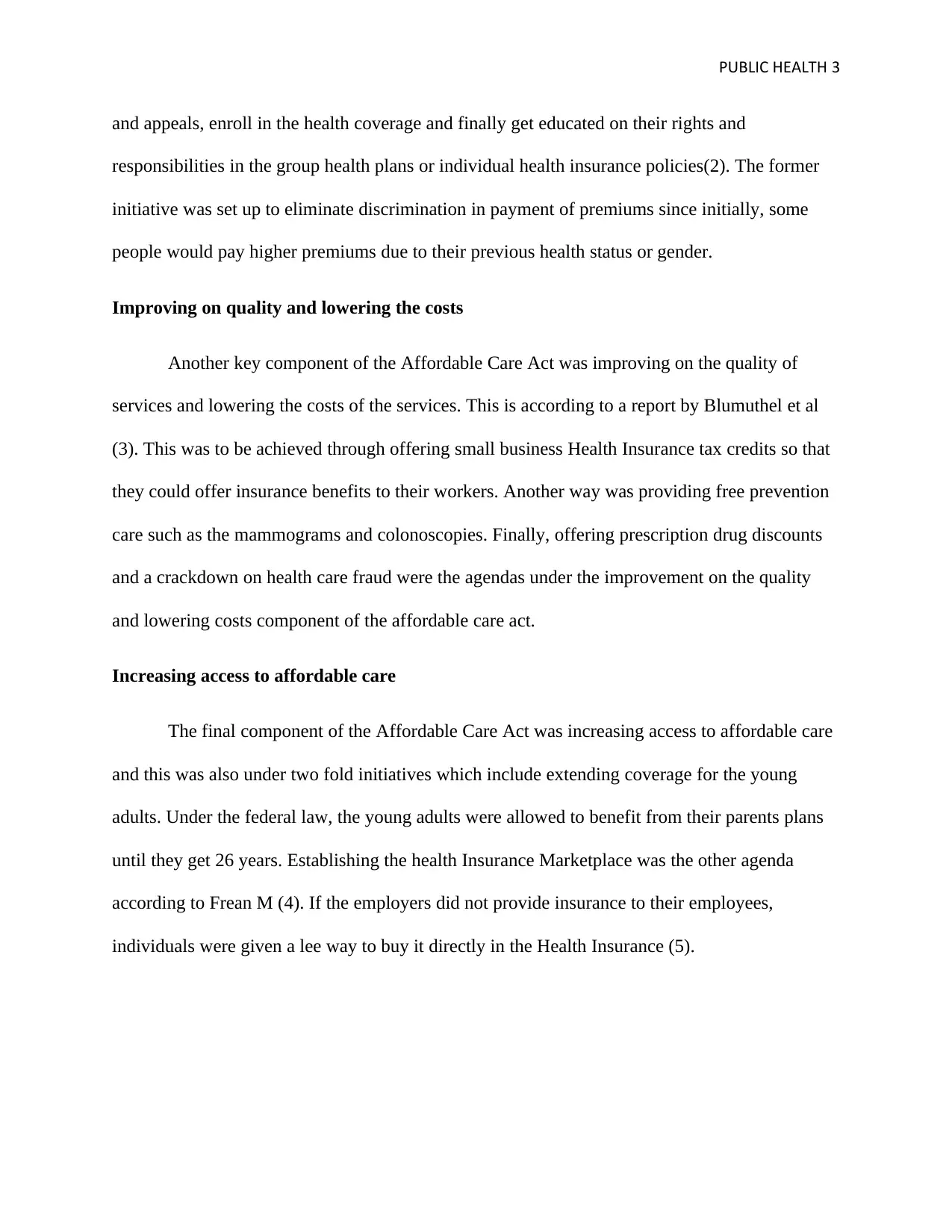
PUBLIC HEALTH 3
and appeals, enroll in the health coverage and finally get educated on their rights and
responsibilities in the group health plans or individual health insurance policies(2). The former
initiative was set up to eliminate discrimination in payment of premiums since initially, some
people would pay higher premiums due to their previous health status or gender.
Improving on quality and lowering the costs
Another key component of the Affordable Care Act was improving on the quality of
services and lowering the costs of the services. This is according to a report by Blumuthel et al
(3). This was to be achieved through offering small business Health Insurance tax credits so that
they could offer insurance benefits to their workers. Another way was providing free prevention
care such as the mammograms and colonoscopies. Finally, offering prescription drug discounts
and a crackdown on health care fraud were the agendas under the improvement on the quality
and lowering costs component of the affordable care act.
Increasing access to affordable care
The final component of the Affordable Care Act was increasing access to affordable care
and this was also under two fold initiatives which include extending coverage for the young
adults. Under the federal law, the young adults were allowed to benefit from their parents plans
until they get 26 years. Establishing the health Insurance Marketplace was the other agenda
according to Frean M (4). If the employers did not provide insurance to their employees,
individuals were given a lee way to buy it directly in the Health Insurance (5).
and appeals, enroll in the health coverage and finally get educated on their rights and
responsibilities in the group health plans or individual health insurance policies(2). The former
initiative was set up to eliminate discrimination in payment of premiums since initially, some
people would pay higher premiums due to their previous health status or gender.
Improving on quality and lowering the costs
Another key component of the Affordable Care Act was improving on the quality of
services and lowering the costs of the services. This is according to a report by Blumuthel et al
(3). This was to be achieved through offering small business Health Insurance tax credits so that
they could offer insurance benefits to their workers. Another way was providing free prevention
care such as the mammograms and colonoscopies. Finally, offering prescription drug discounts
and a crackdown on health care fraud were the agendas under the improvement on the quality
and lowering costs component of the affordable care act.
Increasing access to affordable care
The final component of the Affordable Care Act was increasing access to affordable care
and this was also under two fold initiatives which include extending coverage for the young
adults. Under the federal law, the young adults were allowed to benefit from their parents plans
until they get 26 years. Establishing the health Insurance Marketplace was the other agenda
according to Frean M (4). If the employers did not provide insurance to their employees,
individuals were given a lee way to buy it directly in the Health Insurance (5).
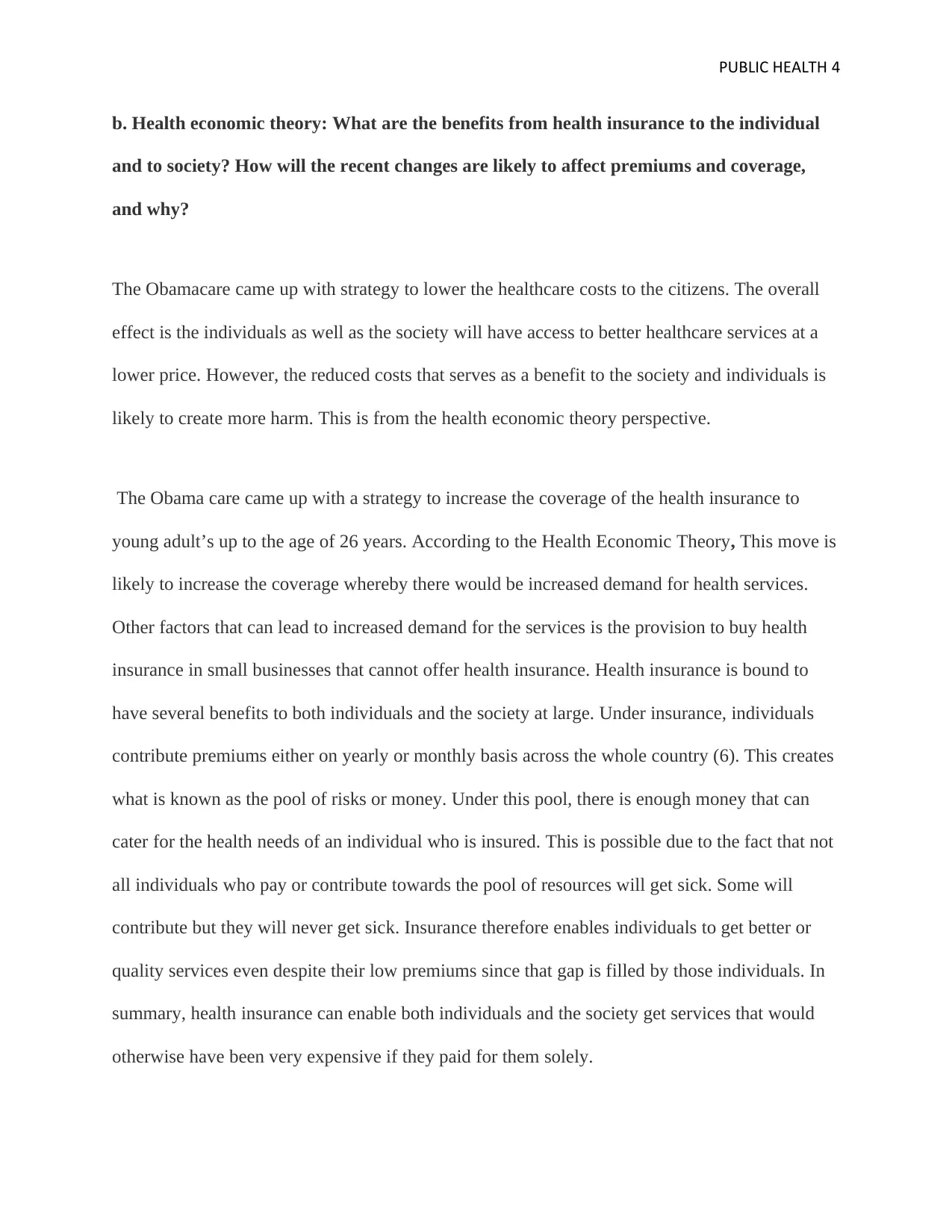
PUBLIC HEALTH 4
b. Health economic theory: What are the benefits from health insurance to the individual
and to society? How will the recent changes are likely to affect premiums and coverage,
and why?
The Obamacare came up with strategy to lower the healthcare costs to the citizens. The overall
effect is the individuals as well as the society will have access to better healthcare services at a
lower price. However, the reduced costs that serves as a benefit to the society and individuals is
likely to create more harm. This is from the health economic theory perspective.
The Obama care came up with a strategy to increase the coverage of the health insurance to
young adult’s up to the age of 26 years. According to the Health Economic Theory, This move is
likely to increase the coverage whereby there would be increased demand for health services.
Other factors that can lead to increased demand for the services is the provision to buy health
insurance in small businesses that cannot offer health insurance. Health insurance is bound to
have several benefits to both individuals and the society at large. Under insurance, individuals
contribute premiums either on yearly or monthly basis across the whole country (6). This creates
what is known as the pool of risks or money. Under this pool, there is enough money that can
cater for the health needs of an individual who is insured. This is possible due to the fact that not
all individuals who pay or contribute towards the pool of resources will get sick. Some will
contribute but they will never get sick. Insurance therefore enables individuals to get better or
quality services even despite their low premiums since that gap is filled by those individuals. In
summary, health insurance can enable both individuals and the society get services that would
otherwise have been very expensive if they paid for them solely.
b. Health economic theory: What are the benefits from health insurance to the individual
and to society? How will the recent changes are likely to affect premiums and coverage,
and why?
The Obamacare came up with strategy to lower the healthcare costs to the citizens. The overall
effect is the individuals as well as the society will have access to better healthcare services at a
lower price. However, the reduced costs that serves as a benefit to the society and individuals is
likely to create more harm. This is from the health economic theory perspective.
The Obama care came up with a strategy to increase the coverage of the health insurance to
young adult’s up to the age of 26 years. According to the Health Economic Theory, This move is
likely to increase the coverage whereby there would be increased demand for health services.
Other factors that can lead to increased demand for the services is the provision to buy health
insurance in small businesses that cannot offer health insurance. Health insurance is bound to
have several benefits to both individuals and the society at large. Under insurance, individuals
contribute premiums either on yearly or monthly basis across the whole country (6). This creates
what is known as the pool of risks or money. Under this pool, there is enough money that can
cater for the health needs of an individual who is insured. This is possible due to the fact that not
all individuals who pay or contribute towards the pool of resources will get sick. Some will
contribute but they will never get sick. Insurance therefore enables individuals to get better or
quality services even despite their low premiums since that gap is filled by those individuals. In
summary, health insurance can enable both individuals and the society get services that would
otherwise have been very expensive if they paid for them solely.
Secure Best Marks with AI Grader
Need help grading? Try our AI Grader for instant feedback on your assignments.
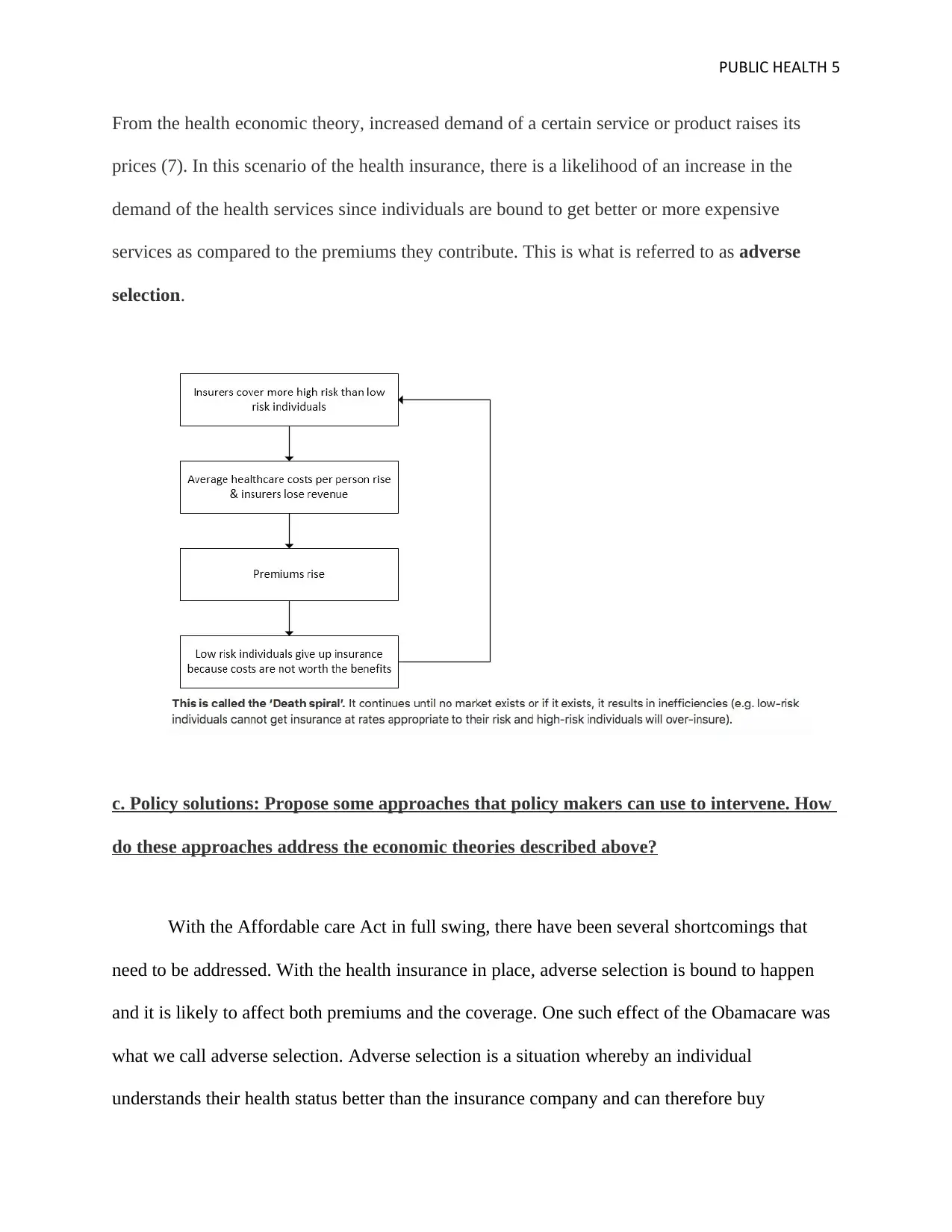
PUBLIC HEALTH 5
From the health economic theory, increased demand of a certain service or product raises its
prices (7). In this scenario of the health insurance, there is a likelihood of an increase in the
demand of the health services since individuals are bound to get better or more expensive
services as compared to the premiums they contribute. This is what is referred to as adverse
selection.
c. Policy solutions: Propose some approaches that policy makers can use to intervene. How
do these approaches address the economic theories described above?
With the Affordable care Act in full swing, there have been several shortcomings that
need to be addressed. With the health insurance in place, adverse selection is bound to happen
and it is likely to affect both premiums and the coverage. One such effect of the Obamacare was
what we call adverse selection. Adverse selection is a situation whereby an individual
understands their health status better than the insurance company and can therefore buy
From the health economic theory, increased demand of a certain service or product raises its
prices (7). In this scenario of the health insurance, there is a likelihood of an increase in the
demand of the health services since individuals are bound to get better or more expensive
services as compared to the premiums they contribute. This is what is referred to as adverse
selection.
c. Policy solutions: Propose some approaches that policy makers can use to intervene. How
do these approaches address the economic theories described above?
With the Affordable care Act in full swing, there have been several shortcomings that
need to be addressed. With the health insurance in place, adverse selection is bound to happen
and it is likely to affect both premiums and the coverage. One such effect of the Obamacare was
what we call adverse selection. Adverse selection is a situation whereby an individual
understands their health status better than the insurance company and can therefore buy
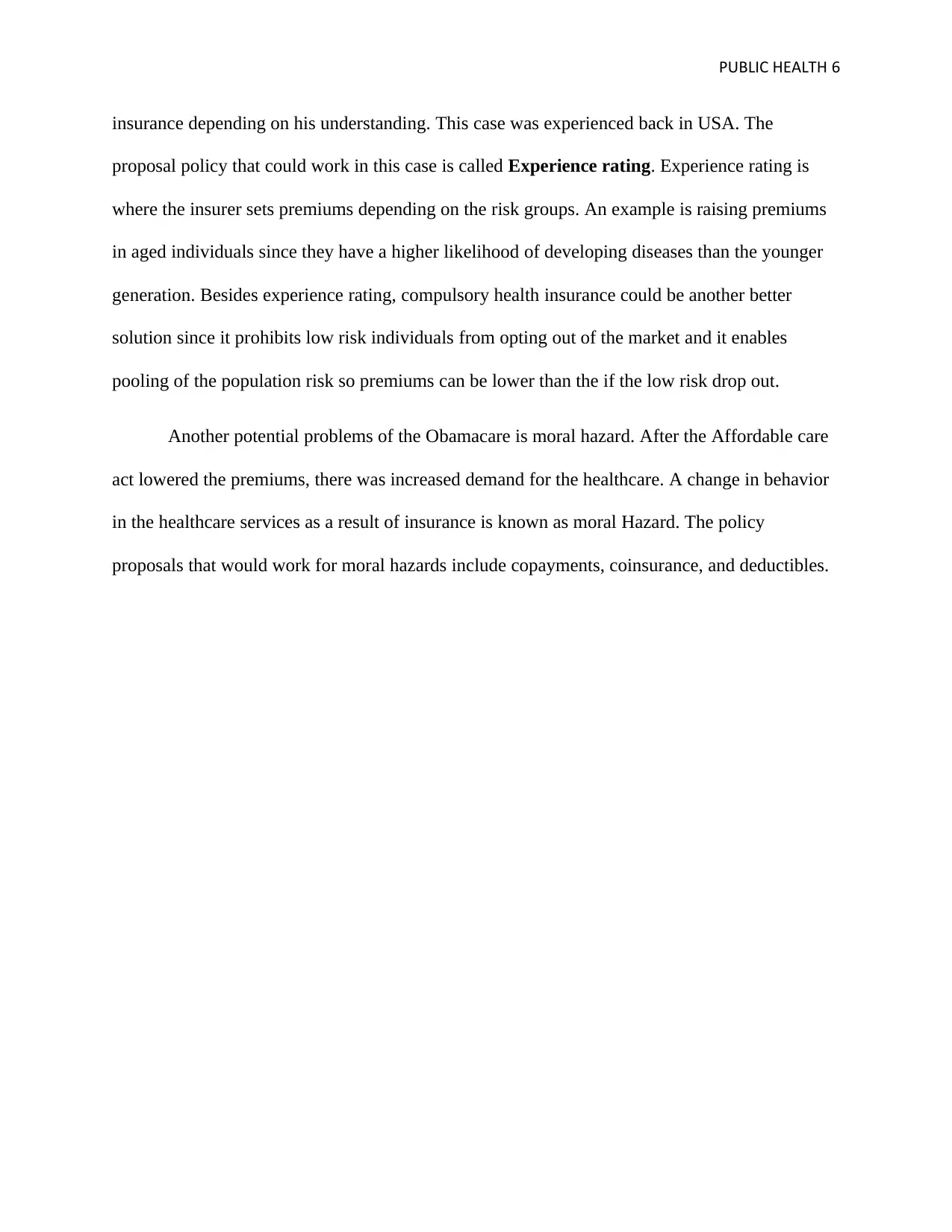
PUBLIC HEALTH 6
insurance depending on his understanding. This case was experienced back in USA. The
proposal policy that could work in this case is called Experience rating. Experience rating is
where the insurer sets premiums depending on the risk groups. An example is raising premiums
in aged individuals since they have a higher likelihood of developing diseases than the younger
generation. Besides experience rating, compulsory health insurance could be another better
solution since it prohibits low risk individuals from opting out of the market and it enables
pooling of the population risk so premiums can be lower than the if the low risk drop out.
Another potential problems of the Obamacare is moral hazard. After the Affordable care
act lowered the premiums, there was increased demand for the healthcare. A change in behavior
in the healthcare services as a result of insurance is known as moral Hazard. The policy
proposals that would work for moral hazards include copayments, coinsurance, and deductibles.
insurance depending on his understanding. This case was experienced back in USA. The
proposal policy that could work in this case is called Experience rating. Experience rating is
where the insurer sets premiums depending on the risk groups. An example is raising premiums
in aged individuals since they have a higher likelihood of developing diseases than the younger
generation. Besides experience rating, compulsory health insurance could be another better
solution since it prohibits low risk individuals from opting out of the market and it enables
pooling of the population risk so premiums can be lower than the if the low risk drop out.
Another potential problems of the Obamacare is moral hazard. After the Affordable care
act lowered the premiums, there was increased demand for the healthcare. A change in behavior
in the healthcare services as a result of insurance is known as moral Hazard. The policy
proposals that would work for moral hazards include copayments, coinsurance, and deductibles.
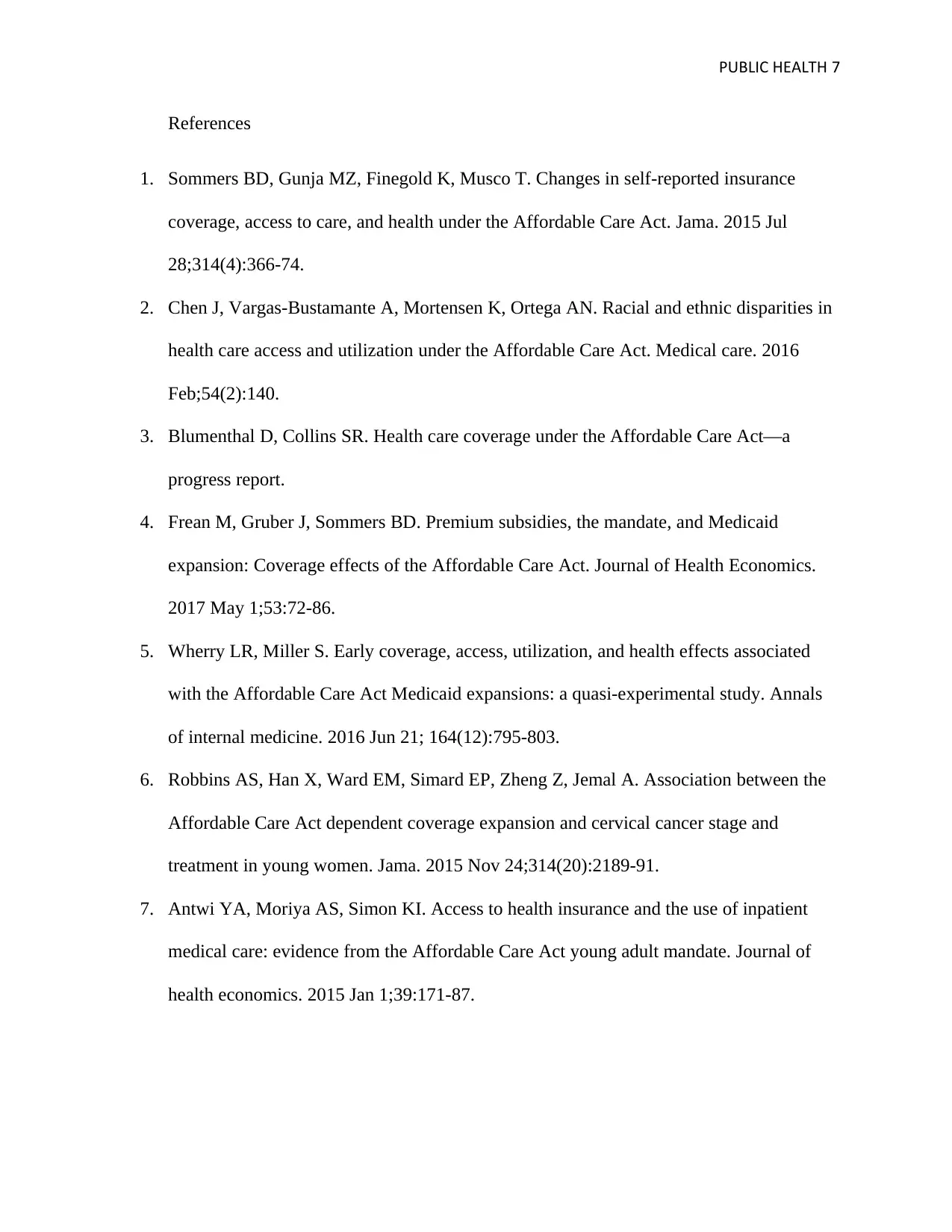
PUBLIC HEALTH 7
References
1. Sommers BD, Gunja MZ, Finegold K, Musco T. Changes in self-reported insurance
coverage, access to care, and health under the Affordable Care Act. Jama. 2015 Jul
28;314(4):366-74.
2. Chen J, Vargas-Bustamante A, Mortensen K, Ortega AN. Racial and ethnic disparities in
health care access and utilization under the Affordable Care Act. Medical care. 2016
Feb;54(2):140.
3. Blumenthal D, Collins SR. Health care coverage under the Affordable Care Act—a
progress report.
4. Frean M, Gruber J, Sommers BD. Premium subsidies, the mandate, and Medicaid
expansion: Coverage effects of the Affordable Care Act. Journal of Health Economics.
2017 May 1;53:72-86.
5. Wherry LR, Miller S. Early coverage, access, utilization, and health effects associated
with the Affordable Care Act Medicaid expansions: a quasi-experimental study. Annals
of internal medicine. 2016 Jun 21; 164(12):795-803.
6. Robbins AS, Han X, Ward EM, Simard EP, Zheng Z, Jemal A. Association between the
Affordable Care Act dependent coverage expansion and cervical cancer stage and
treatment in young women. Jama. 2015 Nov 24;314(20):2189-91.
7. Antwi YA, Moriya AS, Simon KI. Access to health insurance and the use of inpatient
medical care: evidence from the Affordable Care Act young adult mandate. Journal of
health economics. 2015 Jan 1;39:171-87.
References
1. Sommers BD, Gunja MZ, Finegold K, Musco T. Changes in self-reported insurance
coverage, access to care, and health under the Affordable Care Act. Jama. 2015 Jul
28;314(4):366-74.
2. Chen J, Vargas-Bustamante A, Mortensen K, Ortega AN. Racial and ethnic disparities in
health care access and utilization under the Affordable Care Act. Medical care. 2016
Feb;54(2):140.
3. Blumenthal D, Collins SR. Health care coverage under the Affordable Care Act—a
progress report.
4. Frean M, Gruber J, Sommers BD. Premium subsidies, the mandate, and Medicaid
expansion: Coverage effects of the Affordable Care Act. Journal of Health Economics.
2017 May 1;53:72-86.
5. Wherry LR, Miller S. Early coverage, access, utilization, and health effects associated
with the Affordable Care Act Medicaid expansions: a quasi-experimental study. Annals
of internal medicine. 2016 Jun 21; 164(12):795-803.
6. Robbins AS, Han X, Ward EM, Simard EP, Zheng Z, Jemal A. Association between the
Affordable Care Act dependent coverage expansion and cervical cancer stage and
treatment in young women. Jama. 2015 Nov 24;314(20):2189-91.
7. Antwi YA, Moriya AS, Simon KI. Access to health insurance and the use of inpatient
medical care: evidence from the Affordable Care Act young adult mandate. Journal of
health economics. 2015 Jan 1;39:171-87.
1 out of 7
Related Documents
Your All-in-One AI-Powered Toolkit for Academic Success.
+13062052269
info@desklib.com
Available 24*7 on WhatsApp / Email
![[object Object]](/_next/static/media/star-bottom.7253800d.svg)
Unlock your academic potential
© 2024 | Zucol Services PVT LTD | All rights reserved.




